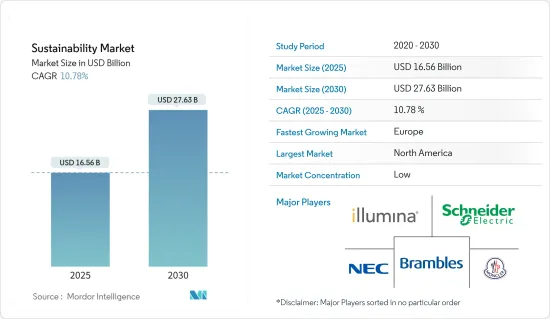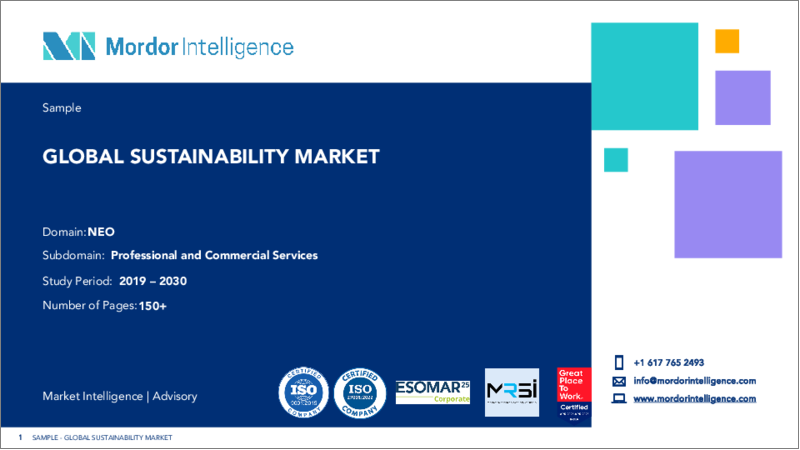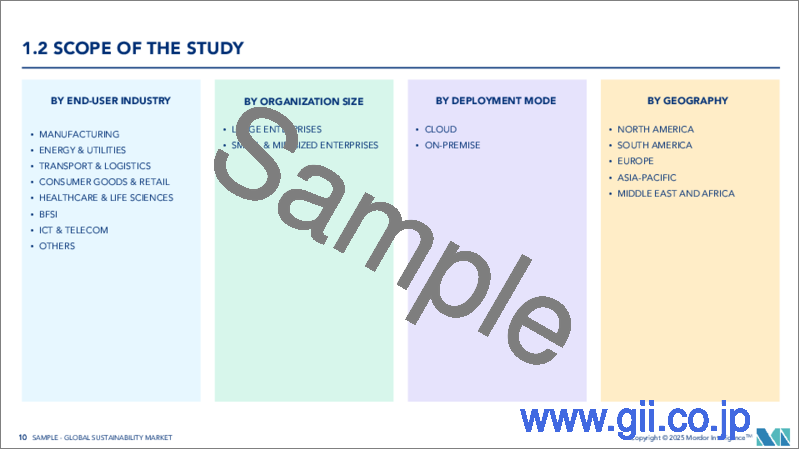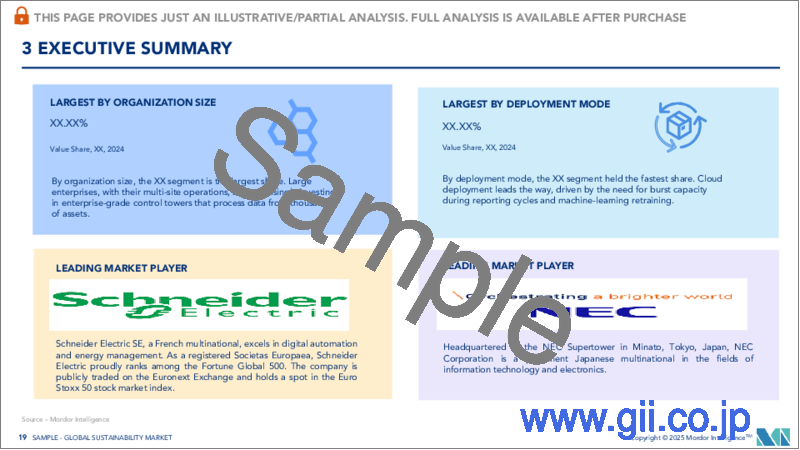|
|
市場調査レポート
商品コード
1651072
サステナビリティ:市場シェア分析、産業動向・統計、成長予測(2025年~2030年)Sustainability - Market Share Analysis, Industry Trends & Statistics, Growth Forecasts (2025 - 2030) |
||||||
カスタマイズ可能
適宜更新あり
|
|||||||
| サステナビリティ:市場シェア分析、産業動向・統計、成長予測(2025年~2030年) |
|
出版日: 2025年02月03日
発行: Mordor Intelligence
ページ情報: 英文 120 Pages
納期: 2~3営業日
|
全表示
- 概要
- 目次
サステナビリティ市場規模は2025年に165億6,000万米ドルと推計され、予測期間(2025-2030年)のCAGRは10.78%で、2030年には276億3,000万米ドルに達すると予測されます。

サステナビリティ市場は、環境保全、社会的責任、経済的存続に特化した多様な分野にまたがっています。主な分野には、再生可能エネルギー、サステナブル農業、廃棄物管理、グリーンビルディング、環境に優しい製品などがあります。法的要件だけでなく、より広範な環境目標へのコミットメントを原動力として、世界中の企業がサステナビリティとグリーンテクノロジーに多額の投資を行っています。こうした投資は、環境にやさしい製品やエネルギー効率の高い技術の開発から、サステナブルサプライチェーンの実践、再生可能エネルギーの導入まで、さまざまな分野に及んでいます。
さらに、企業は研究開発に資金を投入し、二酸化炭素排出量を最小限に抑え、サステナブルソリューションを構築することを目指しています。さらに、リソースと専門知識を結集するために、戦略的提携やパートナーシップが増加しています。さらに、環境・社会・ガバナンス(ESG)要因が投資分野で注目されるようになり、社会意識の高い投資家から資金を集めるようになっています。
サステナビリティ市場の動向
グリーンビルディングへの取り組みの急増が市場成長を後押し
エネルギー効率を重視するグリーンビルディングは、エネルギー消費を大幅に削減しています。これは所有者の運営コストを削減するだけでなく、エネルギー効率の高い技術やソリューションの市場をも押し上げています。数多くの企業がサステナビリティに取り組んでおり、その施設はグリーンビルディング基準に沿っていることが多いです。企業の需要がサステナビリティ市場の拡大に拍車をかけており、環境に優しいソリューションを追求する企業が増えています。グリーン・ビルの設計は、室内空気の質の向上と居住者の福利厚生を優先することが多いです。こうした意識の高まりが、健康に焦点を当てた建築製品や技術に対する市場の関心を高めています。消費者のサステナブルリビングへの関心はますます高まっています。気候変動や環境課題に対する意識が高まる中、消費者は自分の価値観に合った製品や建物を好むようになっており、グリーンビルディング分野の成長を後押ししています。
欧州におけるサステナビリティ市場の需要増加
欧州では、サステナビリティに対する消費者の意識が高まっています。欧州の消費者が環境問題への関心を高めるにつれ、サステナブル製品やサービスを好む傾向が強まっています。このシフトが市場動向を形成し、企業に環境に優しい慣行の導入を促しています。EUは、「森林破壊を防止する製品規制」や「包装・包装廃棄物規制」といったイニシアティブを通じて、より環境に優しい経済を推進しており、これらは企業経営に大きな影響を与えています。エネルギー効率の高いソリューションやサステナブル素材といった技術の進歩もあり、企業はサステナブル慣行を採用する傾向を強めています。こうした技術革新は、企業がサステナビリティの目標を達成する上で極めて重要です。一方、EUは2050年までに気候変動による中立を達成することを目標に掲げています。この目標は、気候変動リスクに対処し、EUの戦略的自律性、競争力、社会的経済モデル、ネット・ゼロ経済における世界的リーダーシップを強化するものです。
サステナビリティ業界の概要
サステナビリティ市場は細分化されています。予測期間中、市場は成長し、競合が激化します。競合情勢には、買収や合併など、プレーヤーが世界の市場シェアを維持するために用いるあらゆる戦略が含まれます。市場の主要企業には、シュナイダーエレクトリック、日本電気、モンクレール、ブランブルズ、イルミナなどが含まれます。
その他の特典:
- エクセル形式の市場予測(ME)シート
- 3ヶ月間のアナリストサポート
目次
第1章 イントロダクション
- 調査の前提条件と市場定義
- 調査範囲
第2章 調査手法
第3章 エグゼクティブサマリー
第4章 市場力学
- 市場概要
- 市場促進要因
- CSR戦略の採用増加により、企業はサステナビリティを事業の中核に据えつつある
- 環境意識の高まりが市場成長を後押し
- 市場抑制要因
- 初期コストの高さが市場を抑制
- サステナブル慣行に対する認識不足が市場成長の阻害要因
- 市場機会
- 企業、政府、NGOの協力によるイノベーションの推進と市場範囲の拡大
- バリューチェーン/サプライチェーン分析
- ポーターの5フォース分析
- 新規参入業者の脅威
- 買い手/消費者の交渉力
- 供給企業の交渉力
- 代替品の脅威
- 競争企業間の敵対関係
- 市場における技術革新に関する洞察
- 市場の規制枠組みに関する洞察
- COVID-19の市場への影響
第5章 市場セグメンテーション
- コンポーネント別
- ソリューション
- サービス別
- 技術別
- モノのインターネット(IoT)
- AIとアナリティクス
- デジタルツイン
- その他(クラウド・コンピューティング、ブロックチェーン)
- 用途別
- グリーンビルディング
- カーボンフットプリント管理
- 大気・水質汚染モニタリング
- 気象モニタリングと予測
- 火災検知
- 作物モニタリング
- その他(土壌状態/水分モニタリング、森林モニタリング)
- 地域別
- 北米
- 米国
- カナダ
- メキシコ
- その他北米地域
- 欧州
- ドイツ
- 英国
- フランス
- ロシア
- スペイン
- その他欧州
- アジア太平洋
- インド
- 中国
- 日本
- その他アジア太平洋地域
- 南米
- ブラジル
- アルゼンチン
- その他南米
- 中東
- UAE
- サウジアラビア
- その他中東
- 北米
第6章 競合情勢
- 市場集中
- 企業プロファイル
- Schneider Electric
- NEC Corporation
- Moncler
- Brambles
- Illumina
- SGS
- Sanofi
- NRI
- Telefonica
- Cigna*
第7章 市場動向
第8章 免責事項と出版社について
The Sustainability Market size is estimated at USD 16.56 billion in 2025, and is expected to reach USD 27.63 billion by 2030, at a CAGR of 10.78% during the forecast period (2025-2030).

The sustainability market spans diverse sectors dedicated to environmental preservation, social responsibility, and economic viability. Key areas include renewable energy, sustainable agriculture, waste management, green building, and eco-friendly products. Across the globe, companies are heavily investing in sustainability and green technology, driven not only by legal requirements but also by a commitment to broader environmental objectives. These investments encompass a range of areas, from creating eco-friendly products and energy-efficient technologies to implementing sustainable supply chain practices and embracing renewable energy sources.
Furthermore, businesses are dedicating funds to research and development, aiming to minimize their carbon footprint and craft sustainable solutions. Furthermore, to leverage combined resources and expertise, strategic alliances and partnerships are on the rise. Additionally, environmental, social, and governance (ESG) factors are gaining prominence in the investment landscape, attracting funds from socially conscious investors.
Sustainability Market Trends
Surge in Green Building Initiatives is Boosting Market Growth
Prioritizing energy efficiency, green buildings are significantly cutting down on energy consumption. This is not only reducing operational costs for owners but also boosting the market for energy-efficient technologies and solutions. Numerous companies are committing to sustainability, often aligning their facilities with green building standards. Corporate demand is fueling the expansion of the sustainability market, with businesses increasingly pursuing eco-friendly solutions. Designs of green buildings often prioritize improved indoor air quality and occupant well-being. This growing awareness is amplifying market interest in health-focused building products and technologies. Consumers are increasingly gravitating towards sustainable living. With a rising consciousness about climate change and environmental challenges, consumers are favoring products and buildings that resonate with their values, thereby propelling the growth of the green building sector.
Increasing Demand for Sustainability Market in Europe
In Europe, consumer awareness of sustainability is on the rise. As European consumers grow more concerned about environmental issues, their preference for sustainable products and services intensifies. This shift is shaping market trends and prompting companies to embrace greener practices. The EU is driving a greener economy through initiatives like the Deforestation-Free Products Regulation and the Packaging and Packaging Waste Regulation, which are significantly impacting business operations. Companies are increasingly adopting sustainable practices, thanks in part to technological advancements like energy-efficient solutions and sustainable materials. These innovations are pivotal in helping firms meet their sustainability objectives. Meanwhile, the EU has set its sights on achieving climate neutrality by 2050. This goal addresses climate change risks and bolsters the EU's strategic autonomy, competitiveness, social economy model, and global leadership in the net-zero economy.
Sustainability Industry Overview
The sustainability market is fragmented. During the forecast period, it is poised for growth, intensifying competition. The competitive landscape includes all the strategies players use to maintain their market share globally, such as acquisitions and mergers. The major players in the market include Schneider Electric, NEC Corporation, Moncler, Brambles, and Illumina.
Additional Benefits:
- The market estimate (ME) sheet in Excel format
- 3 months of analyst support
TABLE OF CONTENTS
1 INTRODUCTION
- 1.1 Study Assumptions and Market Definition
- 1.2 Scope of the Study
2 RESEARCH METHODOLOGY
3 EXECUTIVE SUMMARY
4 MARKET DYNAMICS
- 4.1 Market Overview
- 4.2 Market Drivers
- 4.2.1 Companies are Making Sustainability a Core Aspect of their Operations through Increased Adoption of CSR Strategies
- 4.2.2 Rising Environmental Awareness Fuels Market Growth
- 4.3 Market Restraints
- 4.3.1 High Initial Costs is Restraining the Market
- 4.3.2 Market Growth Hindered by Lack of Awareness on Sustainable Practices
- 4.4 Market Opportunities
- 4.4.1 Companies, Governments, and NGOs Collaborate to Drive Innovation and Expand Market Reach
- 4.5 Value Chain / Supply Chain Analysis
- 4.6 Porters 5 Force Analysis
- 4.6.1 Threat of New Entrants
- 4.6.2 Bargaining Power of Buyers/Consumers
- 4.6.3 Bargaining Power of Suppliers
- 4.6.4 Threat of Substitute Products
- 4.6.5 Intensity of Competitive Rivalry
- 4.7 Insights on Technological Innovations in the Market
- 4.8 Insights on Regulatory Framework in the Market
- 4.9 Impact of COVID-19 on the Market
5 MARKET SEGMENTATION
- 5.1 By Component
- 5.1.1 Solutions
- 5.1.2 Services
- 5.2 By Technology
- 5.2.1 Internet of Things (IoT)
- 5.2.2 AI and Analytics
- 5.2.3 Digital Twin
- 5.2.4 Others (Cloud Computing, Blockchain)
- 5.3 By Application
- 5.3.1 Green Building
- 5.3.2 Carbon Footprint Management
- 5.3.3 Air and Water Pollution Monitoring
- 5.3.4 Weather Monitoring and Forecasting
- 5.3.5 Fire Detection
- 5.3.6 Crop Monitoring
- 5.3.7 Others (Soil Condition/Moisture Monitoring and Forest Monitoring)
- 5.4 Geography
- 5.4.1 North America
- 5.4.1.1 US
- 5.4.1.2 Canada
- 5.4.1.3 Mexico
- 5.4.1.4 Rest of North America
- 5.4.2 Europe
- 5.4.2.1 Germany
- 5.4.2.2 UK
- 5.4.2.3 France
- 5.4.2.4 Russia
- 5.4.2.5 Spain
- 5.4.2.6 Rest of Europe
- 5.4.3 Asia Pacific
- 5.4.3.1 India
- 5.4.3.2 China
- 5.4.3.3 Japan
- 5.4.3.4 Rest of Asia Pacific
- 5.4.4 South America
- 5.4.4.1 Brazil
- 5.4.4.2 Argentina
- 5.4.4.3 Rest of South America
- 5.4.5 Middle East
- 5.4.5.1 UAE
- 5.4.5.2 Saudi Arabia
- 5.4.5.3 Rest of Middle East
- 5.4.1 North America
6 COMPETITIVE LANDSCAPE
- 6.1 Market Concentration
- 6.2 Company Profiles
- 6.2.1 Schneider Electric
- 6.2.2 NEC Corporation
- 6.2.3 Moncler
- 6.2.4 Brambles
- 6.2.5 Illumina
- 6.2.6 SGS
- 6.2.7 Sanofi
- 6.2.8 NRI
- 6.2.9 Telefonica
- 6.2.10 Cigna*





